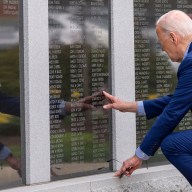 ‘Everything that Remains’ by Joshua Fields Millburn and Ryan Nicodemus, also known as ‘The Minimalists.’
‘Everything that Remains’ by Joshua Fields Millburn and Ryan Nicodemus, also known as ‘The Minimalists.’
Credit: The Minimalists
Below is an excerpt from “Everything that Remains,” a new book by Joshua Fields Millburn and Ryan Nicodemus, also known as “The Minimalists.” They are coming to Boston Wednesday for a talk about the change to a minimalist lifestyle.
I’ll be 32 in a few months, and for the first time in my adult life, I’m free of debt. That’s a weird thing for me to be able say. You see, from the time I was 18—when Chase Bank granted me my first line of credit, a MasterCard with a $5,000 limit, which would’ve made any poor kid from Ohio salivate—until last month, nearly 14 years later, I’ve had some sort of debt. As my twenties mounted, so did my tab with the creditors.
First it was just that one credit card, and then, when that one was maxed out, it was two. And then three. Visa, MasterCard,even Discover. (American Express wasn’t irresponsible enough to grant me a line of credit, not for several years at least.)
But that’s OK, I was “successful,” so I could afford it, right? Fresh out of highschool, I skipped the whole college route and had instead found a sales job that “let” me work six, sometimes seven, days a week, 10–12 hours a day. I wasn’t great at it, but I learned how to get better. By age 19 I was making $50,000 a year. But I was spending $65k. Unfortunately, I was never great at math. Perhaps I should’ve financed a calculator before maxing out half-a-dozen cards.
I celebrated my first big promotion at age 22 the same way I imagined anyone would: I built a house in the suburbs, financed with 0% down. Everything in my culture reaffirmed this decision, even told me I was making a solid investment (this was five years before the housing crash). It wasn’t just any old house, though; it was an oversized, two-storymonstrosity, complete with three bedrooms, two livingrooms, and a full-size basement (the ping-pong table I never used came later, also financed). There was even a white picket fence. I shit you not.
Soon after building the house, I married a wonderful woman. But I was so hyper-focusedon my supposedly impressive career that I hardly remember the ceremony. I know it rained that day, and that my bride was beautiful, and I remember fleeing to Mexico for our (financed) honeymoon after the wedding, but I can’t recall much else. When we returned, I got back to work, filling our two-car garage with luxury cars and our new home with fancy furniture and appliances, stacking debt on top of more debt in the process.I was on the fast track toward the American Dream, just a few years ahead of my contemporaries, who were all spending likewise, albeit five-or-so years later, in their late twenties. But I was ahead of the curve, an exception, right?
At 28, a decade into my accumulation, I was forced to look around at all the stuff surrounding me. It was everywhere. My house was full of things I’d purchased in an attempt to find happiness. Each item had brought with it a twinge of excitement at the check-out line, but the thrill always waned shortly after each purchase, and by the time the credit-card statements arrived, I was overwhelmed with guilt, a strange kind of buyer’s remorse. And so I’d do it all over again, soaking in the suds of consumption—lather, rinse, repeat—in search of something that resembled happiness, an elusive concept that got farther and farther away the more I chased it.
Eventually, happiness was just a speck on the horizon, way off in the distance.
Turns out that I’d been running as fast as I could in the wrong direction. Oops. The stuff wasn’t doing its job; it wasn’t making me happy. In fact, the opposite was true: instead of happiness, I was faced with stress and discontent and anxiety. And massive, crippling debt. And, eventually, depression. I no longer had time for a life outside of work, often laboring 70–80 a week just to pay for the stuff that wasn’t making me happy. I didn’t have time for anything I wanted to do: no time to write, no time to read, no time to relax, no time for my closest relationships. I didn’t even have time to have a cup of coffee with a friend, to listen to their stories. I realized that I didn’t control my time, and thus I didn’t control my own life. It was a shocking realization.
What I did with that revelation, however, is much more important than the revelation itself. Faced with epiphany, I turned around and started walking—not running—in the right direction.I spent two years living under new spending standards, what I refer to as my Ramen Noodles Meal Plan, slashing all my nonessential wants and likesalong the way:I sold the big house (at asignificant post-crashloss) and moved into a small apartment;I paid off my car and kept driving it without considering a new one; I cut up the credit cards and started paying for everything with cash; and I bought only the things I needed. Ultimately, I discovered that Ineededfar less than I’d thought I did. For the first time in my life, I could see happiness getting closer and closer as I walked away from the stuff and toward real happiness. My friends and family started noticing my changed demeanor, too. Over time, life was calmer, less stressed, simpler.
I spent time paying off debt, incrementally, month by month, bill by bill,getting rid of everything superfluous so I could be less tied to my income, less tied to a job that ate all my time.I didn’t simply jump up and quit my job, though. That would’ve been stupid. Instead, it was a long road. It took two laser-focused years to eliminate 80% of my debt, and after I left my careeras I approached age 30, I took a sizablepay cut, but I still focused on paying down the debt, spending two years slapping around that remaining 20%, never losing sight of the freedom that hid behind it.
Follow Michael Naughton on Twitter @metrobosmike.














